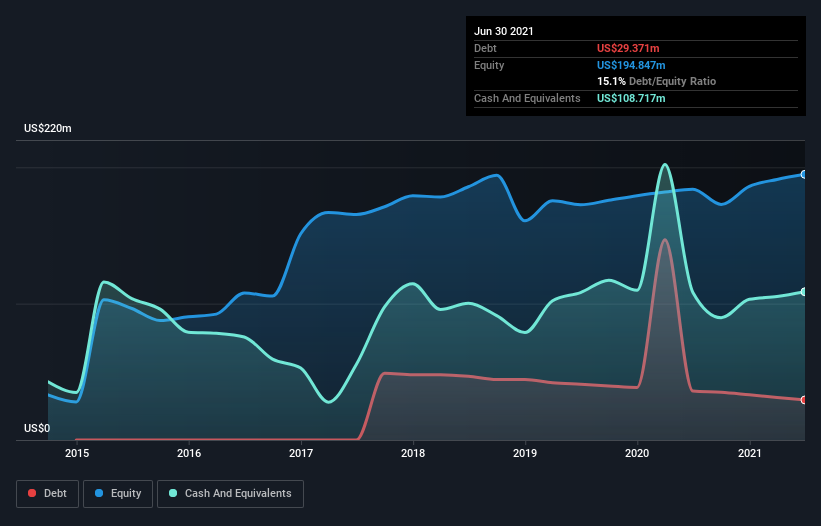We Think Eagle Pharmaceuticals (NASDAQ:EGRX) Can Manage Its Debt With Ease
Howard Marks put it nicely when he said that, rather than worrying about share price volatility, 'The possibility of permanent loss is the risk I worry about... and every practical investor I know worries about.' It's only natural to consider a company's balance sheet when you examine how risky it is, since debt is often involved when a business collapses. We note that Eagle Pharmaceuticals, Inc. (NASDAQ:EGRX) does have debt on its balance sheet. But is this debt a concern to shareholders?
When Is Debt A Problem?
Debt and other liabilities become risky for a business when it cannot easily fulfill those obligations, either with free cash flow or by raising capital at an attractive price. Ultimately, if the company can't fulfill its legal obligations to repay debt, shareholders could walk away with nothing. However, a more usual (but still expensive) situation is where a company must dilute shareholders at a cheap share price simply to get debt under control. Of course, debt can be an important tool in businesses, particularly capital heavy businesses. When we think about a company's use of debt, we first look at cash and debt together.
View our latest analysis for Eagle Pharmaceuticals
How Much Debt Does Eagle Pharmaceuticals Carry?
As you can see below, Eagle Pharmaceuticals had US$29.4m of debt at June 2021, down from US$35.9m a year prior. But it also has US$108.7m in cash to offset that, meaning it has US$79.3m net cash.
A Look At Eagle Pharmaceuticals' Liabilities
The latest balance sheet data shows that Eagle Pharmaceuticals had liabilities of US$44.7m due within a year, and liabilities of US$24.7m falling due after that. Offsetting these obligations, it had cash of US$108.7m as well as receivables valued at US$52.7m due within 12 months. So it actually has US$92.0m more liquid assets than total liabilities.
This surplus suggests that Eagle Pharmaceuticals has a conservative balance sheet, and could probably eliminate its debt without much difficulty. Succinctly put, Eagle Pharmaceuticals boasts net cash, so it's fair to say it does not have a heavy debt load!
Even more impressive was the fact that Eagle Pharmaceuticals grew its EBIT by 179% over twelve months. That boost will make it even easier to pay down debt going forward. The balance sheet is clearly the area to focus on when you are analysing debt. But it is future earnings, more than anything, that will determine Eagle Pharmaceuticals's ability to maintain a healthy balance sheet going forward. So if you're focused on the future you can check out this free report showing analyst profit forecasts.
Finally, a company can only pay off debt with cold hard cash, not accounting profits. While Eagle Pharmaceuticals has net cash on its balance sheet, it's still worth taking a look at its ability to convert earnings before interest and tax (EBIT) to free cash flow, to help us understand how quickly it is building (or eroding) that cash balance. Over the last three years, Eagle Pharmaceuticals actually produced more free cash flow than EBIT. There's nothing better than incoming cash when it comes to staying in your lenders' good graces.
Summing up
While it is always sensible to investigate a company's debt, in this case Eagle Pharmaceuticals has US$79.3m in net cash and a decent-looking balance sheet. The cherry on top was that in converted 171% of that EBIT to free cash flow, bringing in US$44m. So we don't think Eagle Pharmaceuticals's use of debt is risky. Above most other metrics, we think its important to track how fast earnings per share is growing, if at all. If you've also come to that realization, you're in luck, because today you can view this interactive graph of Eagle Pharmaceuticals's earnings per share history for free.
When all is said and done, sometimes its easier to focus on companies that don't even need debt. Readers can access a list of growth stocks with zero net debt 100% free, right now.
This article by Simply Wall St is general in nature. We provide commentary based on historical data and analyst forecasts only using an unbiased methodology and our articles are not intended to be financial advice. It does not constitute a recommendation to buy or sell any stock, and does not take account of your objectives, or your financial situation. We aim to bring you long-term focused analysis driven by fundamental data. Note that our analysis may not factor in the latest price-sensitive company announcements or qualitative material. Simply Wall St has no position in any stocks mentioned.
Have feedback on this article? Concerned about the content? Get in touch with us directly. Alternatively, email editorial-team (at) simplywallst.com.

 Yahoo Movies
Yahoo Movies 

